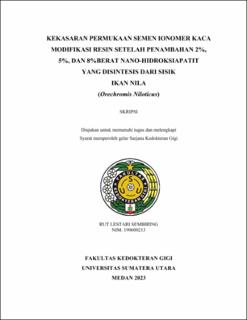Kekasaran Permukaan Semen Ionomer Kaca Modifikasi Resin Setelah Penambahan 2%, 5%, dan 8%Berat Nano-Hidroksiapatit yang Disintesis dari Sisik Ikan Nila (Orechromis Niloticus)
Surface roughness of resin modified glass ionomer cement after the addition of 2%, 5% and 8%by weight nano-hydroxyapatite tilapia (Oreochromis niloticus) scales

Date
2023Author
Sembiring, Rut Lestari
Advisor(s)
Harahap, Kholidina Imanda
Metadata
Show full item recordAbstract
The addition of nano-hydroxyapatite can improve the physical properties of
resin-modified glass ionomer cement (RMGIC). Nano-hydroxyapatite can be
synthesized from natural materials, such as tilapia fish scales. The purpose of this study
was to determine the difference in surface roughness of RMGIC after the addition of
2%, 5% and 8% by weight of nano-hydroxyapatite from tilapia (Oreochromis
niloticus) fish scales. Nano-hydroxyapatite (51,71 nm) was synthesized from tilapia
scales using the calcination method at 800OC for 5 hours and a ball-mill to obtain nanosized
particles, then measured with the Particle Size Analyzer. Samples were made
from RMGIC with nano- hydroxyapatite with a diameter of 5 mm and a height of 2
mm. A total of 40 samples were divided into 4 groups, namely control (group 1), and
the addition of 2% (group 2), 5% (group 3), 8% (group 4) by weight of
nanohydroxyapatite. The ratio of resin modified glass ionomer cement powder: nanohydroxyapatite:
liquid of each group is 0.150:0.000:0.050g; 0.147:0.003:0.050g;
0.142:0.007:0.050g; 0.138:0.012:0.050g. The mixture was stirred until it was
homogeneous and then put into the master cast which had been coated with celluloid
strips then covered on top with celluloid strips and object glass and given a load of 1
kg for 15 seconds. Then light cured for 20 seconds using a light curing unit. Surface
roughness evaluation is using a profilometer. Data were analyzed using the One Way Anova test and the Post-Hoc LSD test. The results of the surface roughness test for
groups 1, 2, 3 and 4 were 1,49 ± 0,23 μm; 0,87 ± 0,1 μm; 0,67 ± 0,1 μm; 0,40 ± 0,06
μm. The results of the One Way Anova test, there was a difference in surface roughness
between treatment groups (p<0,05). It can be concluded that there was a difference in
the surface roughness of RMGIC after the addition of nano-hydroxyapatite. There was
a significant decrease in surface roughness after adding 2%, 5% and 8%by weight of
nano-hydroxyapatite
Collections
- Undergraduate Theses [1901]
